Is your USB drive indicating that it needs to be formatted? Many Windows users have encountered this annoying problem:
“My computer says the flash drive I use is unreadable and needs to be formatted - is there anything I can do to not lose the files on it? Is there a good way to get the files without reformatting? Or to format the flash drive, then recover the files? Thanks in advance for any suggestions.”reddit.com
Thankfully, in most cases, it is possible to recover files from a flash drive that needs formatting.
However, you need to follow the right order of actions, or the problem may get worse. In the next section, we will show you exactly what to do.
What Should You Do if Your USB Says It Needs to Be Formatted
When the Windows operating system shows the error message below, it indicates that it cannot correctly read/write data from/to the USB flash drive.
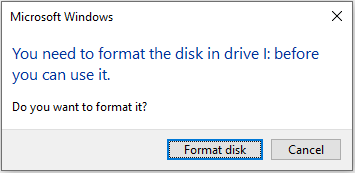
If we are discussing a brand-new pen drive that doesn’t have a file system, a mention that you have to “format a USB drive before use” might not be concerning.
However, the situation changes if you have been utilizing that storage device and have vital data saved on it.
Don’t worry!
Typically, you can take some quick actions as below to effectively and safely deal with the USB formatting issue.
Action 1. Do Not Format the USB Drive Yet
There are many scenarios in which the message indicating the USB drive requires formatting can pop up.
For example, an incompatible file system, file system corruption, a new USB flash drive, etc., can cause the problem.
Do NOT format it yet!
In all situations, formatting should be considered a last option, since it will delete all data on the drive.
Action 2. Recover & Save Your Files
Is it possible to recover files from a USB flash drive that needs to be formatted?
Yes! You can utilize one of the best USB data recovery software to retrieve your files from the pen drive that prompts for formatting.
When a USB flash drive says it needs to be formatted, it may be due to a corrupted or unsupported file system in the current operating system.
Therefore, the best app to deal with such a data recovery situation should:
- Be capable of retrieving data from corrupted file systems.
- Support all commonly used file systems across major operating systems.
- Recognize and recover files from storage devices that seem unformatted or in RAW format.
- Be user-friendly and have a fast recovery engine to ensure you can extract your files promptly.
Action 3. Find the Cause of the USB Formatting Problem
What causes your flash drive to suddenly indicate that it requires formatting?
There are several factors that may lead to the unformatted error, and it’s important to understand these causes so you can be cautious and avoid this issue with your USB flash drive in the future:
- Incompatible File System: If your USB drive is formatted with EXT3/4 or another file system that Windows doesn’t recognize, Windows will prompt you to format the drive.
- File System Damage: The file system (e.g., FAT32, NTFS, exFAT) on the USB drive may become damaged due to unsafe ejection, power interruptions, or crashes during file transfers.
- Viruses and Malware Infection: USB drives are particularly vulnerable to virus attacks when connected to unsecured devices or used for storing risky files. If a USB drive is infected by a virus, Windows may restrict access to protect your system.
- USB Hardware Malfunctions: Sometimes, hardware malfunctions with the USB drive can lead Windows to recommend formatting. This might be caused by a malfunctioning USB port, a broken USB cable, or issues with the drive itself.
- Bad Sectors: Bad sectors can lead to subpar performance of the USB flash drive and prevent Windows from reaching the data saved on these problematic sectors.
- Physical Damage: A USB drive that has sustained physical damage will cease to function, making repairs significantly more challenging.
- A Brand-new USB: If the USB drive is brand new, it may not have a file system yet. In such situations, Windows will prompt you to format the drive before it can be utilized.
Action 4. Fix the USB Formatting Problem
Once you have secured your data from your USB flash drive, you can move on to repairing it.
Ideally, you should be able to resolve any logical file system errors without needing to format.
Therefore, start by using the Windows Error Checking tool and CHKDSK in Command Prompt to correct file system issues. Additionally, changing the drive letter may potentially fix the hardware conflict.
If these methods fail, formatting the device may be necessary. We offer four ways for you to format your USB effectively and safely.
How to Recover Files from Flash Drive That Needs to Be Formatted
As we mentioned above, before rushing to the specific repairing solutions, the first thing is learning how to recover data from USB that needs to be formatted if you don’t want to lose your data.
MiniTool Power Data Recovery is highly recommended.
Why MiniTool data recovery app?
Because MiniTool Power Data Recovery is one of the best data recovery software for Windows 8/8.1, Windows 10, and Windows 11.
It excels in every aspect when it comes to retrieving data from various storage devices, including flash drives that require formatting.
Here’s what it brings to the table for today’s task:
- Skillfully manage corrupted file systems, allowing for data recovery even in the most difficult scenarios.
- Scan and recover files from storage devices that seem unformatted or in RAW format.
- Provide file system-level recovery (supporting FAT32, exFAT, NTFS, and EXT4 on Windows).
- Feature a clean and intuitive interface that is easy to navigate.
This free data recovery tool allows you to recover up to 1 GB of data for free.
MiniTool Power Data Recovery FreeClick to Download100%Clean & Safe
Here’s how to recover data from a USB drive that’s asking to be formatted using MiniTool Power Data Recovery for Windows:
Step 1. Scan the Target USB Drive
Make sure the USB drive is connected to your computer properly.
Open the free file recovery tool to access its primary interface. Here, your USB drive should appear in the Logical Drives tab.
Move your cursor to the target USB drive and click the Scan button to start the scanning process.
Your USB drive might not show a typical volume label because of file system problems. You can determine the target drive by looking at the partition size and drive letter.
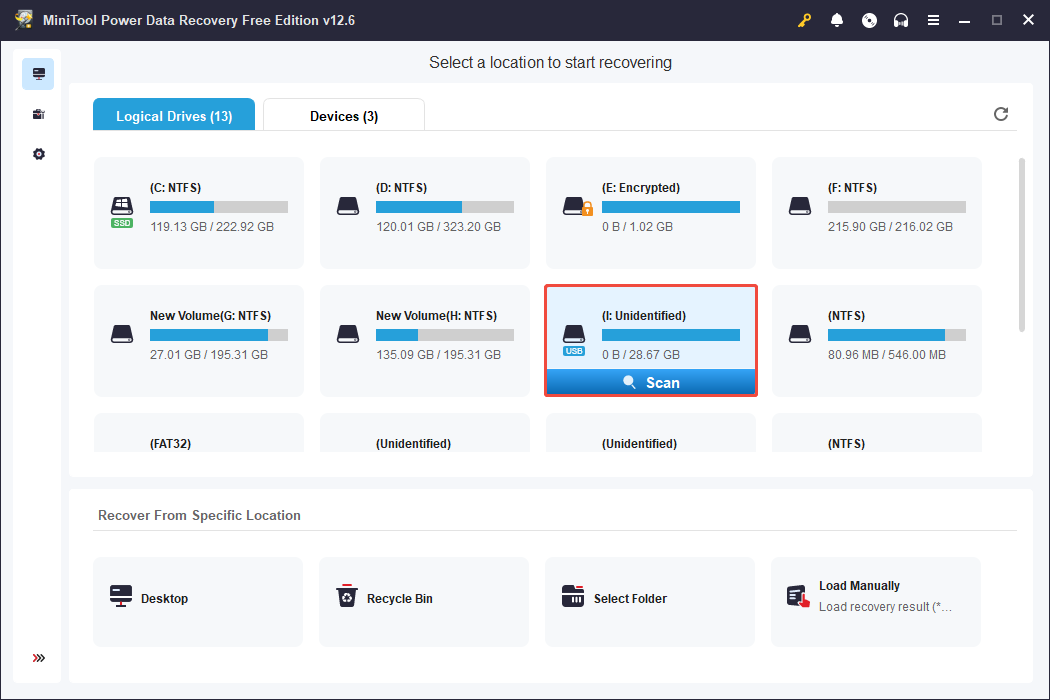
It’s recommended to wait patiently until the scan finishes to obtain the most exhaustive scan results.
Step 2. Filter and Preview the Found Files
Once the scanning process is complete, all found files are shown under the Path category by default. You can remain in this section and expand each folder to search for the files you need.
Alternatively, you can switch to the Type category, which allows you to view and locate files by their type.
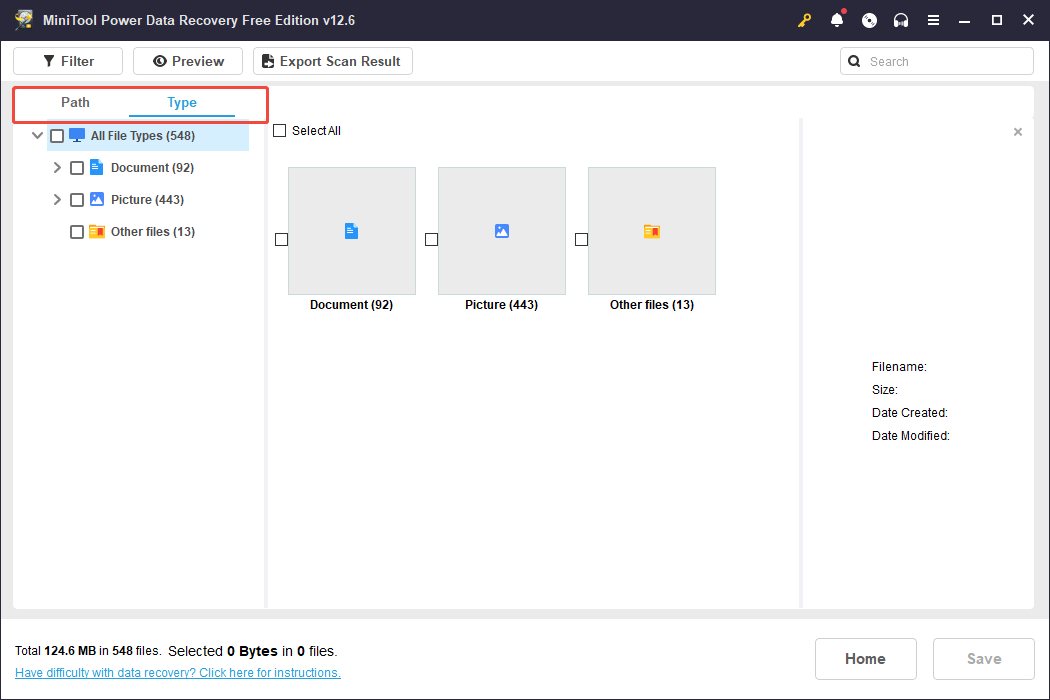
Additionally, this file recovery tool offers two more features to help you locate files more quickly.
- Filter: On the results page after the scan, clicking the Filter button will bring up useful options that allow you to refine the displayed files by file type, modification date, file size, and file category.
- Search: If you’re looking for a specific file, you can type the full or partial file name in the search box at the top right corner and press Enter. This will display folders or files that match the name you entered.
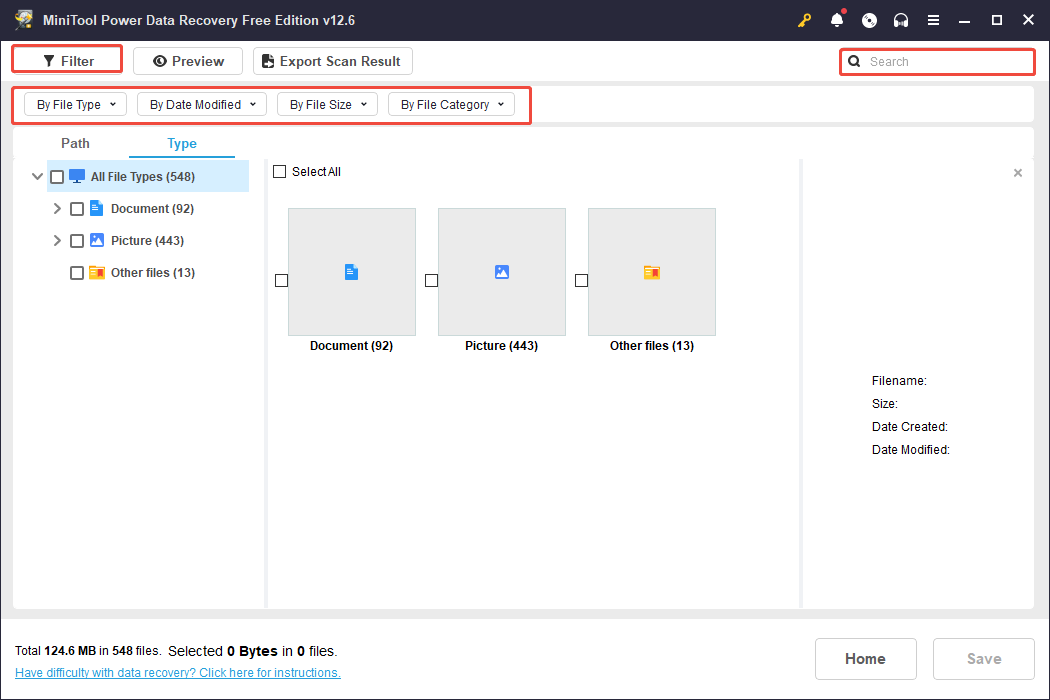
MiniTool Power Data Recovery allows recovery of up to 1 GB of files for free. It’s essential to preview files before saving to ensure they are reliable and accessible.
Supported file types for preview include documents, images, videos, audio files, etc.
To preview, double-click the file or select it and click the Preview button.
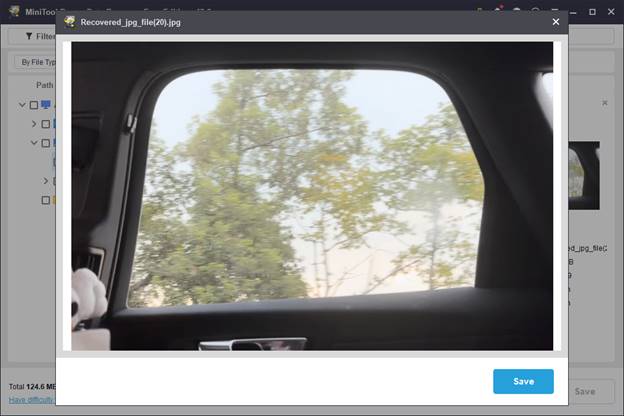
Step 3. Select and Save All Wanted Files
Lastly, check the box next to each necessary file and click the Save button.
When the small pop-up window appears, select a secure location to save the restored files and click OK.
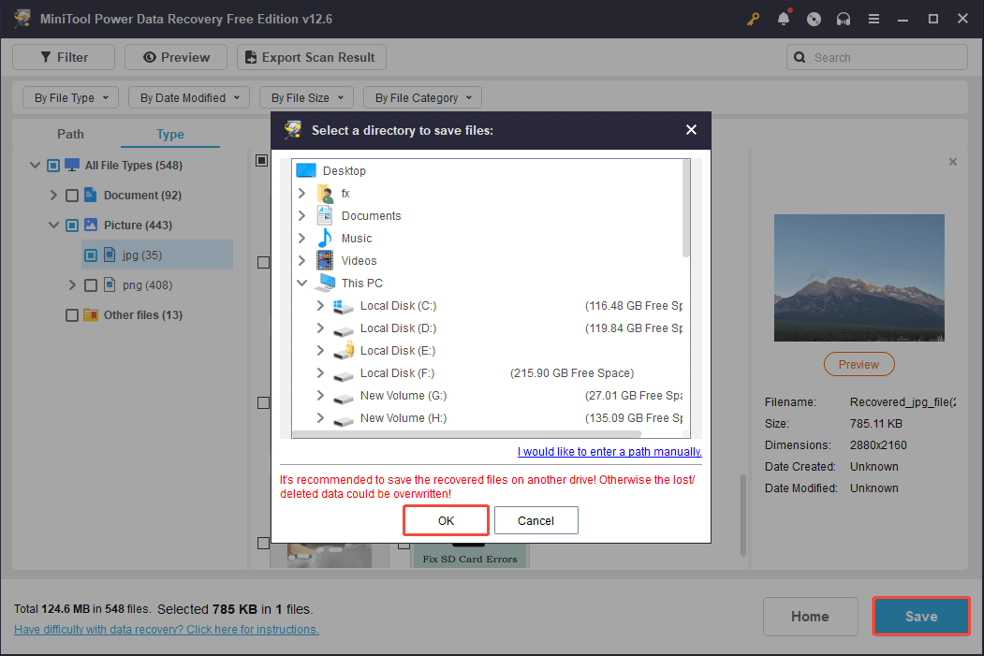
How to Fix a USB Drive That Needs Formatting
With your important files successfully retrieved, you can consider one of the options below to resolve the issue of a USB drive requesting formatting.
Solution 1. Use the Windows Error Checking Tool
Windows has a built-in tool for checking and repairing disk errors, which may occasionally fix a flash drive that requires formatting.
Step 1. Press Win + E to open File Explorer.
Step 2. Move on to the This PC section, then right-click the target problematic USB and select Properties from the context menu.
Step 3. Under the Tools tab, click the Check button to check the drive for file system errors.
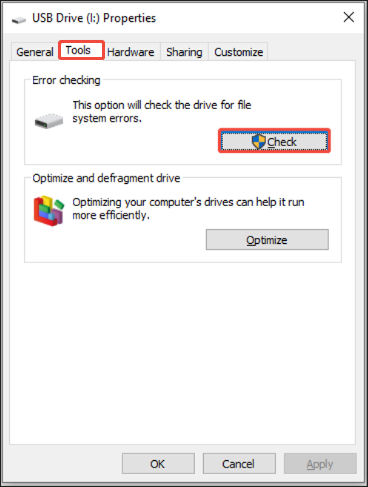
Solution 2. Change a Drive Letter
In some cases, the problem may be due to a drive letter conflict or a temporary glitch. Some users reported that reassigning a new drive letter solved the problem.
Follow the instructions to do it:
Step 1. Right-click the Start button and select Disk Management.
Step 2. In Disk Management, right-click the USB’s partition and then select the option Change Drive Letter and Paths.
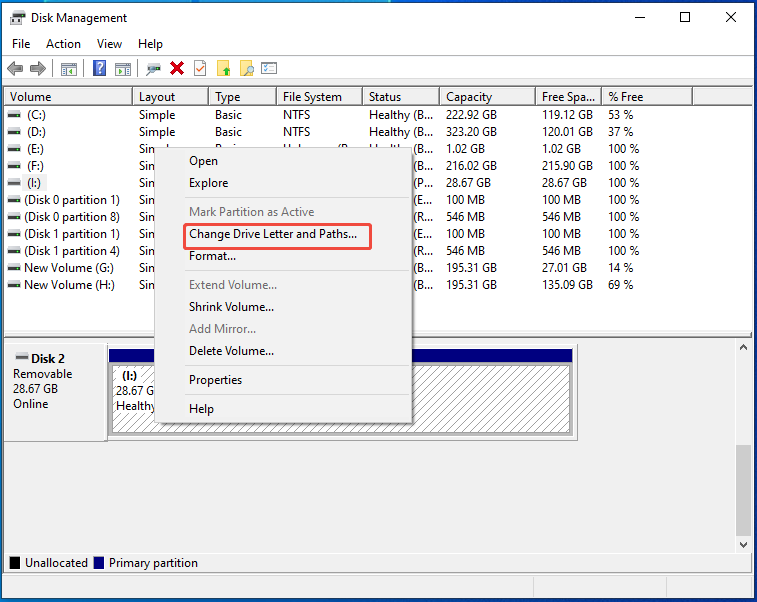
Step 3. In the pop-up window, click the Change button. On the next page, select a drive letter and click OK to save the changes you have made.
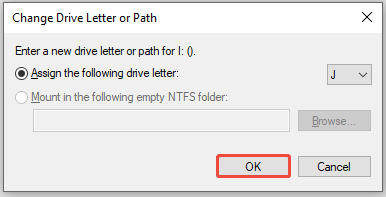
Step 4: Click Yes to confirm the action.
Solution 3. Repair Bad Sectors Using CHKDSK
CHKDSK is a command-line tool in Windows that is utilized to check a drive’s file system for any errors and try to correct them. It can detect and mend logical file system faults, bad sectors, and various other issues.
Here’s how:
Step 1. Run Command Prompt as an administrator.
Step 2. Type chkdsk X: /f (replace X with the drive letter of your USB drive) and press Enter.
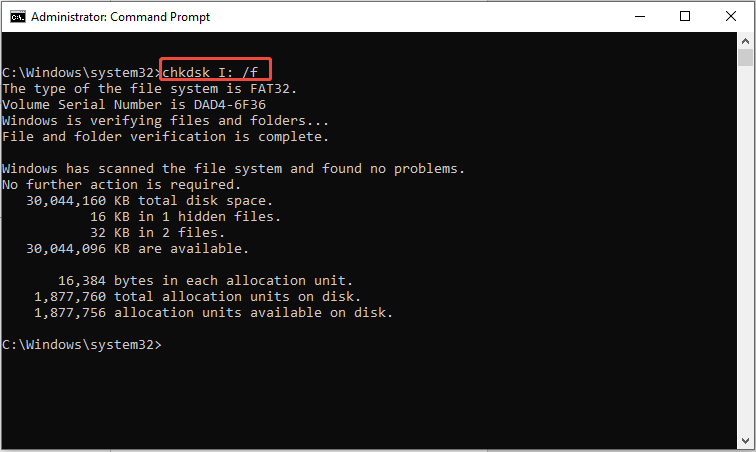
The command will scan your USB drive for errors, display detailed results, and attempt to repair any problems it finds. After it finishes, check if your USB drive is accessible.
Sometimes, you may receive the error message saying “The type of the file system is RAW. CHKDSK is not available for RAW drives.”
In this situation, you need to format your USB by following the next solution.
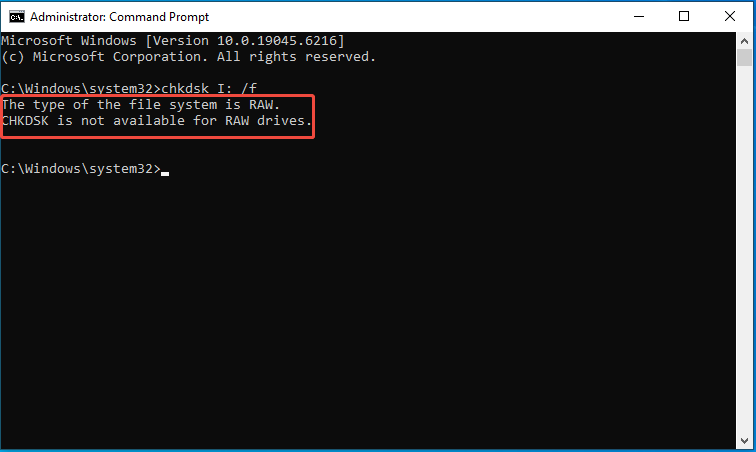
Solution 4. Format the USB Drive
If none of the above methods work, the last method is formatting your USB.
Before doing so, make sure you have recovered all the required files. Once confirmed, follow what your OS suggests and format the device.
There are several methods to format a storage device like a USB flash drive on Windows.
Option A. In the File Explorer
File Explorer offers the simplest method for formatting a disk on Windows 11/10. Here’s what to do:
Step 1. Press Win + E to open the File Explorer.
Step 2. Click on This PC. You will view all the drive partitions.
Step 3. Right-click on the USB drive and choose Format from the options presented.
Step 4. Select the file system. For external drives, it is recommended to choose FAT32 or exFAT.
Step 5. Check the Quick Format option.
Step 6. Press Start and then click OK to confirm the formatting operation on the partition.
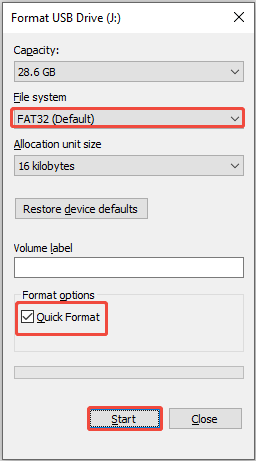
Option B. In the Disk Management
You can utilize Disk Management to format a new hard drive on Windows or reformat an existing one.
Step 1. Press Win + R to open the Run command window.
Step 2. Type diskmgmt.msc and press Enter to access Disk Management.
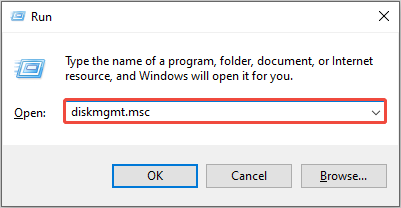
Step 3. Right-click on the USB’s partition and choose Format.
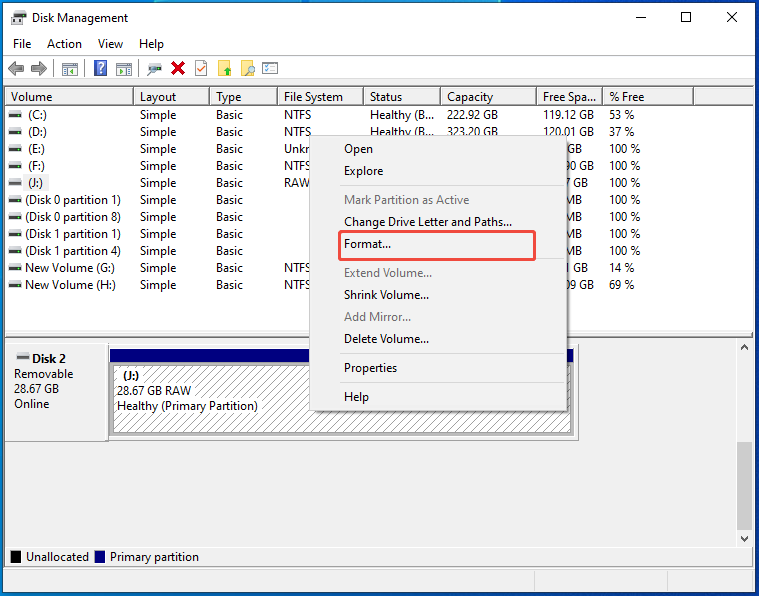
Step 4. Provide a name for the volume, select a file system, check the Perform a quick format option, and click OK.
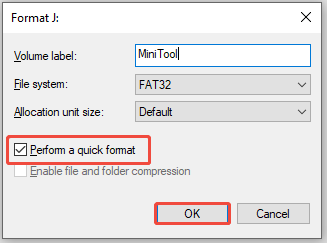
Step 5. Click OK in the pop-up window to finish the formatting operation.
Option C. Use DiskPart
The DiskPart command-line tool provides advanced management functions for disks and partitions, including formatting.
Just follow the steps outlined below carefully:
Step 1. Press Win + R to open the Run window.
Step 2. Type diskpart in the window and then click OK.
Step 3. Type the following commands in the DiskPart window and press Enter after each one:
- list disk
- select disk X (X stands for the number of the disk you want to format)
- list partition
- select partition X (X stands for the number of the partition you want to format)
- format fs=ntfs quick (You can switch ntfs to other file systems, like fat32)
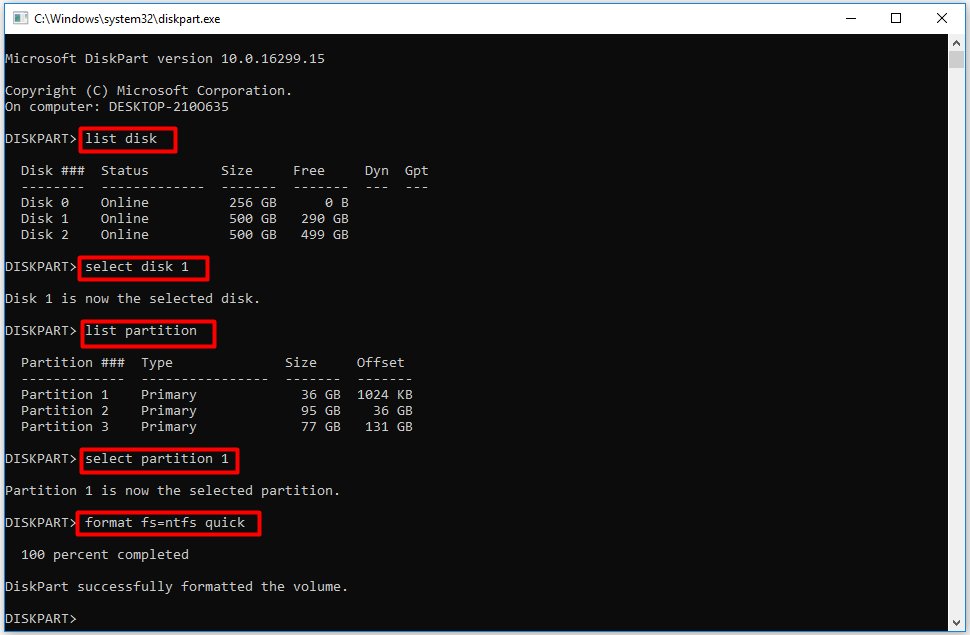
Option D. Use a USB Formatter
Formatting a USB flash drive is quite easy using MiniTool Partition Wizard. This free partition management tool works with almost all of the USB stick brands and supports various file systems, including NTFS, FAT32, exFAT, EX2/3/4, etc.
MiniTool Partition Wizard FreeClick to Download100%Clean & Safe
Here’s how to format a USB using MiniTool Partition Wizard.
Step 1. Open MiniTool Partition Wizard. Select the USB and then click on the Format Partition option in the action panel.
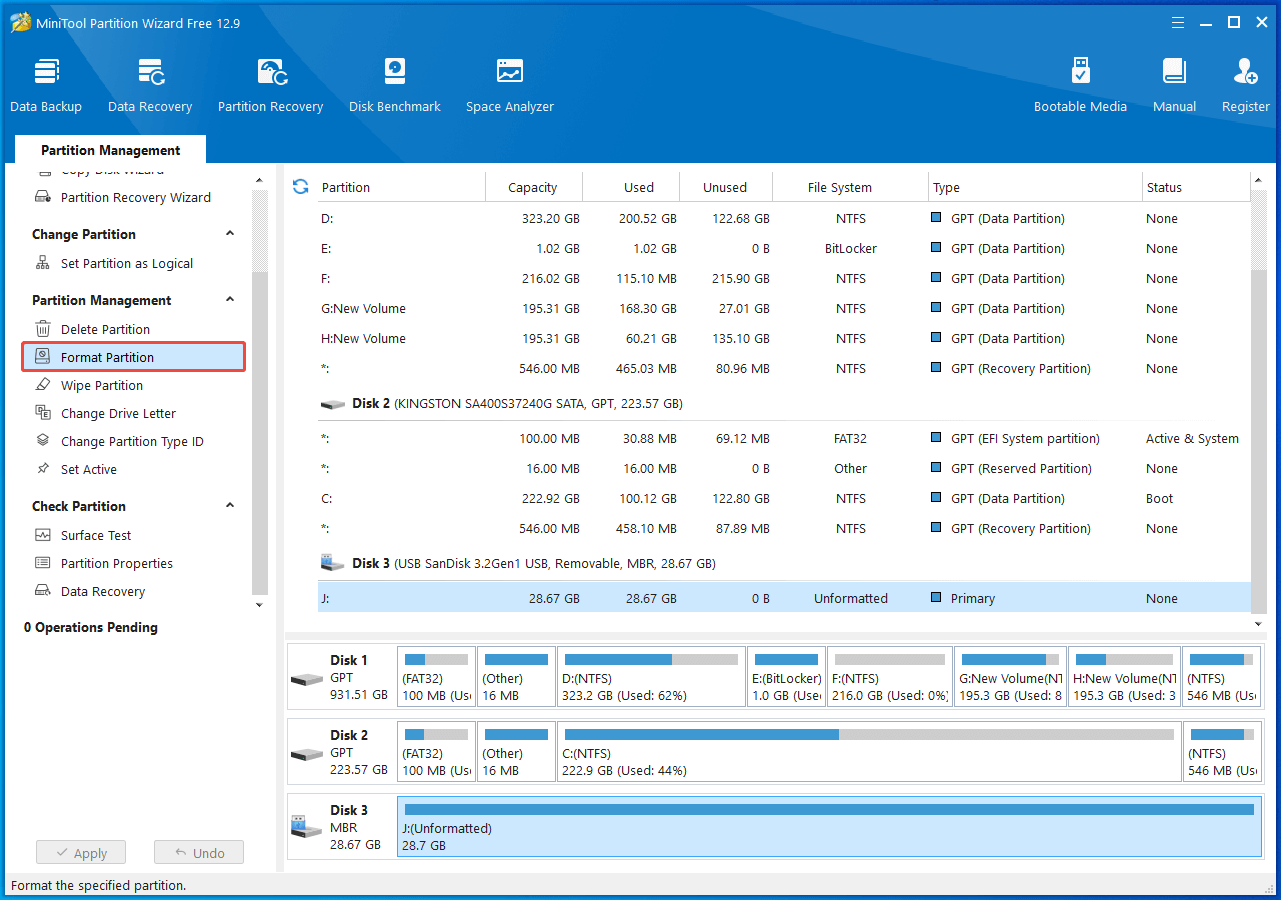
Step 2. After specifying the partition label and the desired file system, click the OK button to proceed with the process.
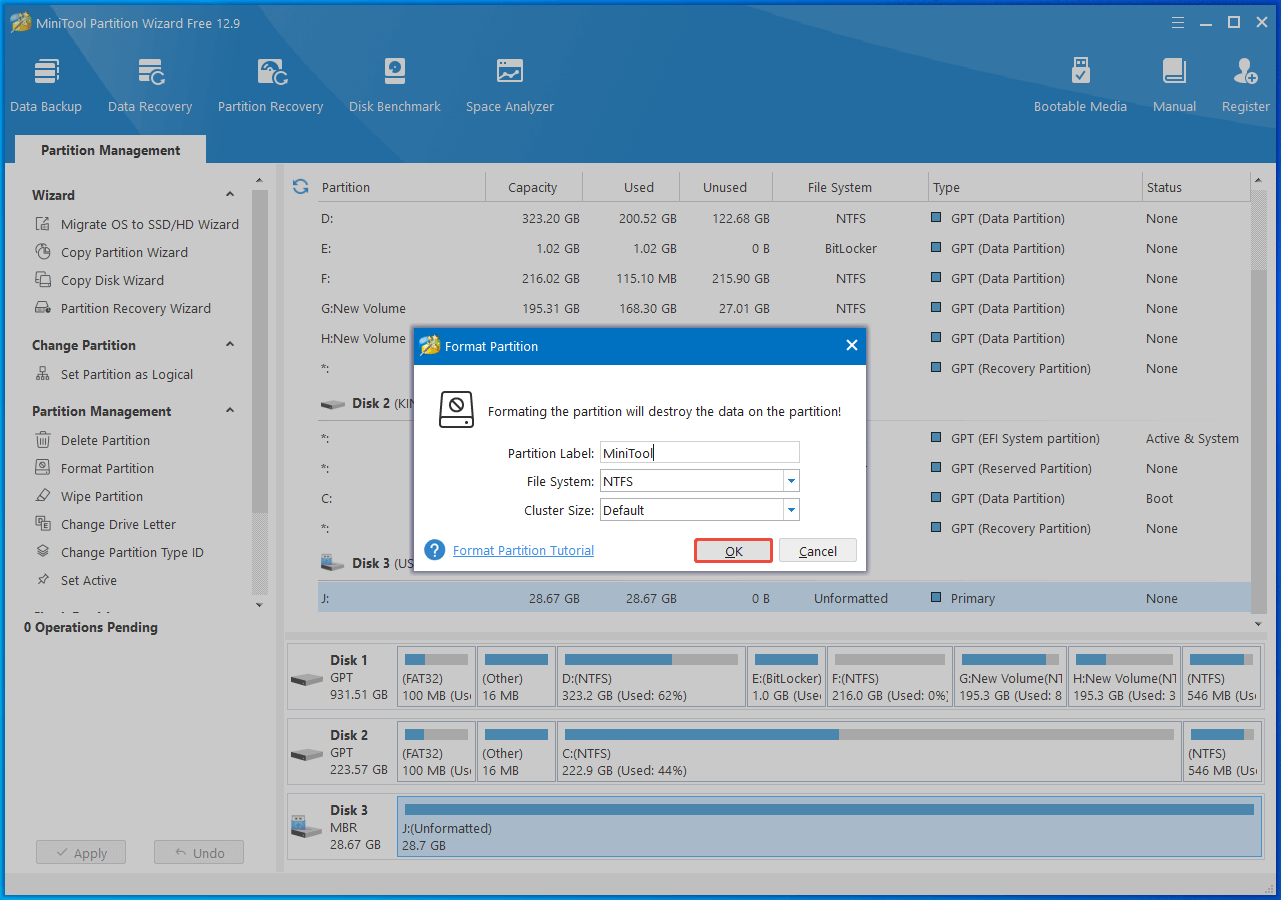
Step 3. Click Apply to carry out the pending operation.
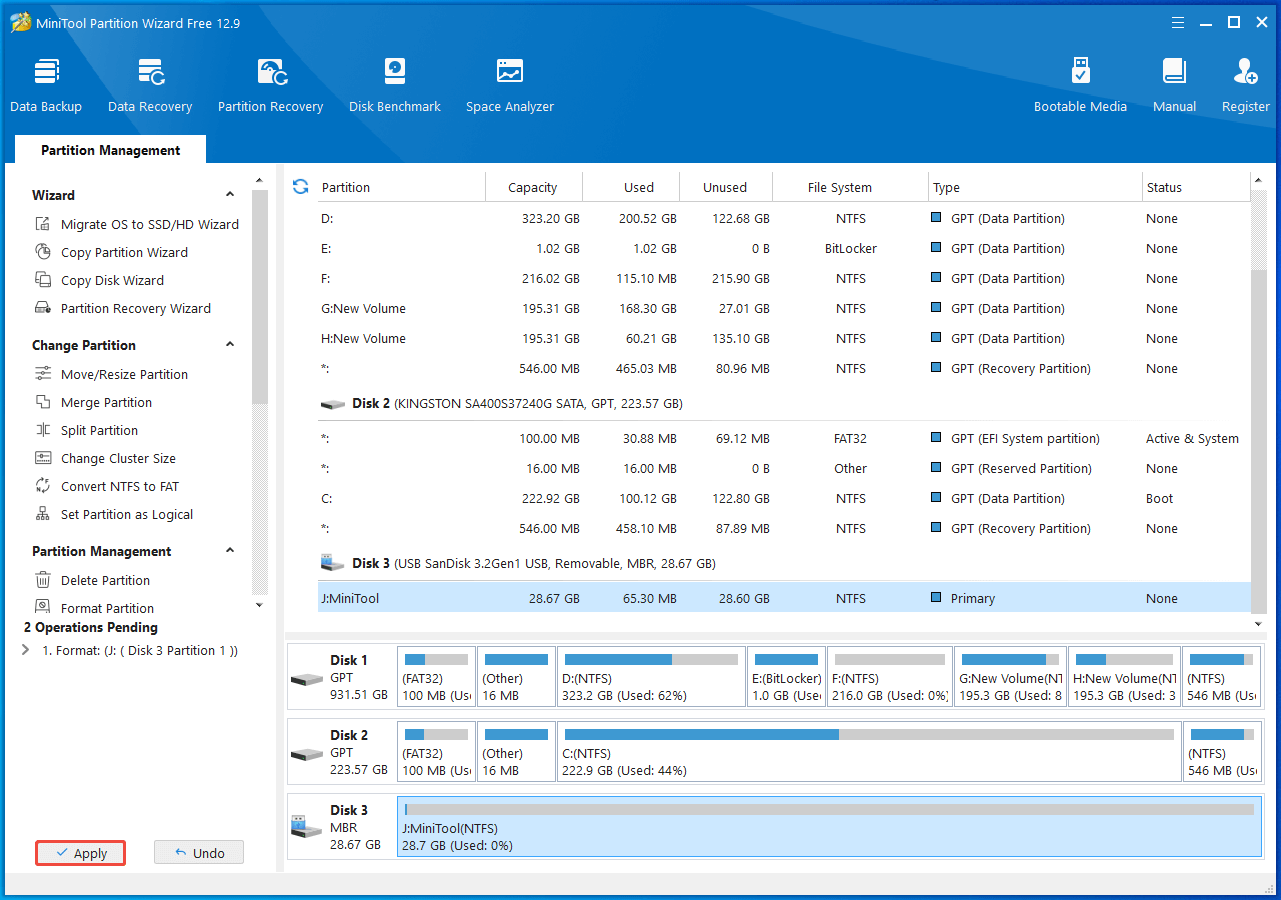
Solution 5. Seek Professional Help
If the data recovery software cannot recover your files and the issue cannot be fixed, the drive may have a physical issue. In such cases, you can contact a professional data recovery service to rescue your data.
How to Avoid Future Occurrences of the USB Needs to Be Formatted Issue
Here are some suggestions to prevent the message that the USB drive needs to be formatted from appearing:
- Ensure that you safely eject your USB drive from your computer.
- Utilize trustworthy antivirus software and keep it updated to safeguard your USB drive against viruses and malware.
- Avoid dropping, bending, or subjecting your USB drive to extreme temperatures and other harmful conditions.
- Regularly back up crucial files from your USB drive to avoid losing data if the drive requires formatting. MiniTool ShadowMaker, a professional Windows backup tool, can help back up files.
MiniTool ShadowMaker TrialClick to Download100%Clean & Safe
Wrap Up
Now you should know how to recover files from flash drive that needs to be formatted on Windows. Additionally, you can try the practical methods mentioned above to repair the unformatted error.
First, consider using the Windows Error Checking tool and changing a drive letter. Then, try using CHKDSK to fix the issue.
If nothing happens, you can choose to format your USB drive from the File Explorer, Disk Management, use DiskPart, or a third-party formatter.
If you encounter any problems or have any questions about MiniTool software, please send an email to the support team via [email protected].


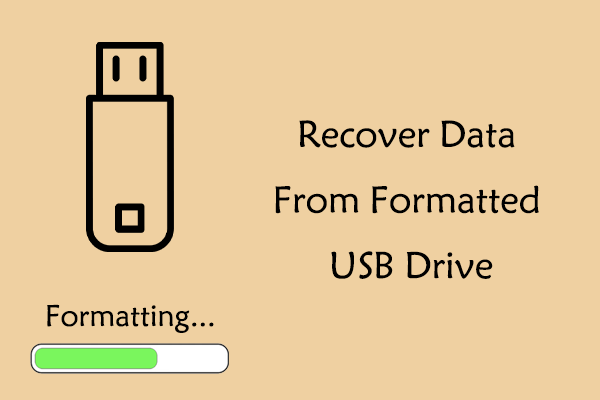

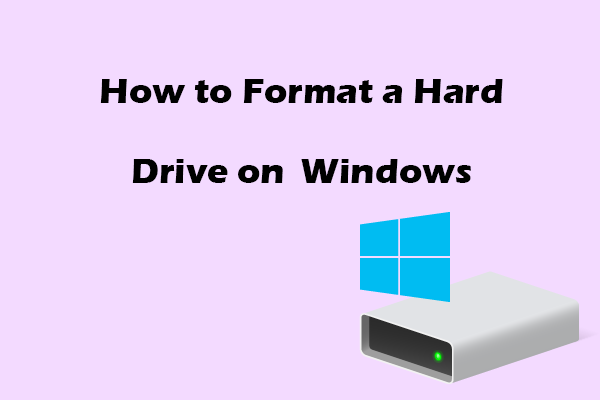
User Comments :